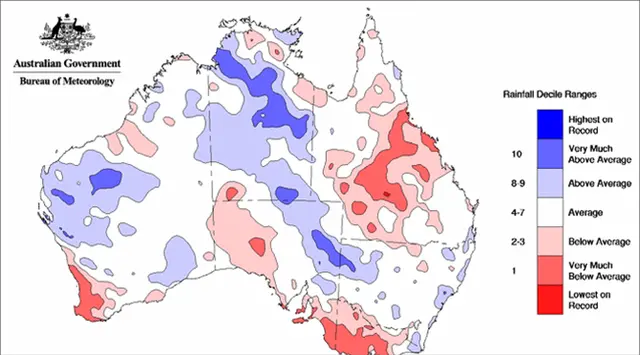(The Conversation)
TodaytheAustralianBureauofMeteorologyhasreleaseditsyearlyclimateupdate.AstrongElNiñoeventwastheheadlinestoryunderlyingglobalclimatein2015,butitsimpactinAustraliawasmixed.
Insomepartsofthecountryitwasaverydryyear,butsomeotherpartswhicharenormallyhithardbyElNiño–especiallylargepartsofNewSouthWales–gotoffratherlightly.RecordhightemperaturesintheIndianOceanwerepartofthemix,providingasourceofmoistureattimesoverautumnandwinterwhichoffsetthedryinginfluenceofElNiño.
Afterafalsestartinlate2014,full-blownElNiñoconditionsdevelopedinthetropicalPacificOceanbyMay2015.TheeventintensifiedrapidlyandwentontobecomeoneofthestrongestElNiñoeventsofthelast50years,alongside1982-83and1997-98.
Inmanypartsoftheworld,ElNiño’simpactonclimatefollowedtheusualscript.Inparticular,therewasseriousdroughtinthesecondhalfoftheyearinIndonesia,PapuaNewGuineaandmanyofthewesternSouthPacificislands,alongwithnorthernSouthAmerica,CentralAmericaandtheCaribbean.InAustralia,thesituationwasmorecomplicated.
VerydryinpartsofAustralia
Nationally,rainfallin2015wasbelownormal,althoughnowherenearrecord-breakinglevels.Thenationalannualtotalwas5%belowthe1961-1990average.
Asubstantialproportionof2015’srainfellinJanuary,especiallyinnorthernandcentralAustralia.AliceSpringshadthree-quartersofitsannualaveragerainfallinthespaceofaweek(andthenhadonly10millimetresinthenextninemonths).IfJanuarywastakenoutofthepicturetheyearwasmuchdrier.TheFebruary-Novemberperiodwastheninth-driestonrecordnationally,andinthenorthernhalfofAustraliaitwasthedriestsince1951.HeavyrainreturnedinDecemberinthenortherntropics,particularlytheNorthernTerritory,whichhaditswettestDecemberonrecord.
Thestandoutdryregionsof2015werethesouthwestofWesternAustraliaandaregionofthesoutheastencompassingcentralandwesternVictoria,thesoutheastofSouthAustralia,andpartsofTasmania.
InthesouthwestofWesternAustraliaaveragerainfallfortheMay-Novembergrowingseasonwasthesecondlowestonrecordafter2010.Tasmaniarankedseventh-driestforthisperiod,andVictoriaeleventh.
SpringwasespeciallydryinTasmania,whereitwaseasilythedriestonrecord,andbothTasmaniaandVictoriahadtheirdriestyearssince2006.
InbothsouthwestWesternAustraliaandVictoria,thedryconditionsin2015wereanintensificationonlong-termrainfalldeficitslastingseveralyears,withVictorianrainfallsincemid-2012returningtolevelstypicalofthe1997to2009MillenniumDrought.
2015wasalsoarelativelydryyearformuchofinlandQueenslandandadjacentnorthernNewSouthWales.
Someofthehardest-hitdroughtareasdidabitbetterthantheyhadin2013or2014andnorthwestQueenslandhadusefulrainattheendof2015.Butrainfallwasstillgenerallybelownormalandnotenoughtomakeanyseriousinroadsintothemulti-yeardroughtafflictingtheregion.
ItwasalsoanotablydryyearinpartsofcoastalnorthQueensland,withTownsvilleamongthecentreshavingitsdriestyearonrecord.SomecoastalregionsfurthersouthhadheavyraininFebruaryfromCycloneMarcia,whichmadelandfallnorthofRockhampton,thesouthernmostknowncategory5cyclonelandfallontheQueenslandcoast.
Incontrasttothedrynessfurthernorthandsouth,NewSouthWaleshadnear-normalrainfallin2015.Theinlandreceivedreasonablyregularrainthroughtheyear,whilethecoasthadseveralmajordownpoursassociatedwitheastcoastlows.DestructivefloodingaffectedtheHunterregioninAprilandtheIllawarrainAugust.
TherainfallextendedtosoutheastQueensland.Brisbanehaditssecond-wettestyearofthe21stcentury,withparticularlyheavyraininearlyMayandnumerousseverethunderstormsduringthespring.
Coolstart,hotend
ForAustralianmeantemperaturesitwasayearoftwohalves.Autumntemperatureswereslightlybelownormal,butitwasanexceptionallywarmfinishtotheyear.Thelastquarter(October-December)oftheyearwaseasilythehottestonrecord.Overtheyearasawhole,temperatureswere0.83°Cabovethe1961-90average,makingitthefifthwarmestyearonrecord.
2013,2014and2015haveallrankedinthefivewarmestyearsonrecordforAustralia.ThelastthreeyearshavealsoseenAustralia’sthreewarmestsprings,with2015fallingjustshortof2014’srecordhigh.Australia’s2015temperatureswererelativelymodestbyglobalstandards,withtheworldsettohaveitshottestyearonrecordbymorethan0.1°Cabovetherprevioushottestyear(2014).Finalglobalnumbersfor2015willnotbeavailableuntillaterthismonth.
ThewarmthinAustraliawasespeciallyexceptionalinOctober.Nationally,temperatureswere2.89°Cabovethe1961-90average,whichintermsofdegreesaboveaveragemakesitthemostextrememontheverexperiencedforAustraliantemperatures.
MostofthesouthernhalfofmainlandAustraliahaditshottestOctoberonrecord,withaveragemaximumtemperaturesforthemonthmorethan7°CabovenormalinpartsofVictoria.Victoria’sOctobertemperatureswereaboutthoseofanormalDecember.
Melbournehaditsearliest-everspringdayabove35°C,andSydneyitssecond-earliest.Theheatduringspringwasassociatedwithanumberofmajorunseasonablefiresacrossthesouthernstateswithlossoflifeandproperty.TherewasfurtherextremeheatinDecember,withMildurarecordingVictoria’shighest-everovernightminimumtemperature(31.9°C),andVictoria,TasmaniaandSouthAustraliaallexperiencingtheirhottestDecembersonrecord.
2015’swarmthextendedovermostpartsofthecountry,withtemperaturesabovenormaleverywhereexceptpartsoftheinteriornorthwestandsouthernTasmania.ThewarmthwasmostpronouncedinWesternAustraliaandQueensland.Temperatureswere1.0to1.5°CaboveaverageovermostofWesternAustraliaoutsideoftheKimberley,aswellasovermostofsouthernandcentralQueensland,apartfromtheeastcoastfromMackaysouthwards.
ItwasthehottestyearonrecordinpartsofsouthernWesternAustraliaandwasthesecondhottestyearfortheStateasawhole,whilstrecordswerealsosetinQueenslandinaregioncentredonTownsvilleandinpartsofthecentralandsoutherninterior.
Oneexceptiontothewarmthcameinwinter,whenitwasrathercoldoverthesoutheastquarterofthecountry.Tasmaniahaditscoldestwintersince1966andVictoriaitscoldestsince1997,althoughVictoriantemperatureswerestillonly0.26°Cbelowaverage.Thecoldextendedfurthernorthinmid-July,bringingthemostsignificantsnowfallssince1984tohigherelevationsinQueenslandandnorthernNewSouthWales.
WinterinNewSouthWaleswas0.22°Caboveaverage.Thestatehasnowhadeighteenwintersinarowwithabove-normaltemperatures,anindicationofhowrarecoldwintershavebecomeinrecentyears.
ElNiñoisexpectedtodeclineoverthefirsthalfof2016,althoughitremainstobeseenwhetheritwilltransitiondirectlyintoaLaNiñaevent(ashappenedin1998)orreturntonear-normal(neutral)conditions.
Historically,adecliningElNiñotypicallyhaslimitedinfluenceonAustralianrainfallfromJanuaryonwards,butisstillassociatedwithhighertemperatures,especiallyinthefirsthalfoftheyear.
 简体中文
简体中文

